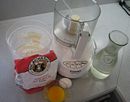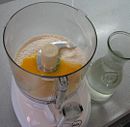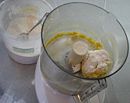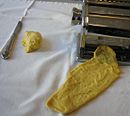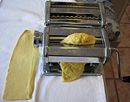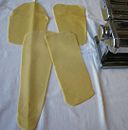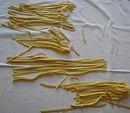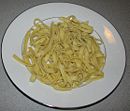Tagliatelle: Difference between revisions
imported>Hayford Peirce (added captions; now Stephen can work his magic on this whole gallery if he wants to) |
mNo edit summary |
||
| (2 intermediate revisions by one other user not shown) | |||
| Line 1: | Line 1: | ||
{{subpages}} | {{subpages}} | ||
[[Image:Bolognese 7.jpg|thumb|right|{{#ifexist:Template:Bolognese 7.jpg/credit|{{Bolognese 7.jpg/credit}}<br/>|}}[[Bolognese sauce]] served on homemade tagliatelle with freshly grated ''[[Parmigiano-Reggiano]]'' cheese.]] | |||
'''Tagliatelle''' is a well-known form of [[pasta]] that originated in the [[Emilia-Romagna]] region of northern [[Italy]], where it is particularly known as being the classic accompaniment to [[Bolognese sauce]]. A single piece is a long, flat ribbon indistiguishable from fettuccine except for its slightly greater width of about 1/4th of an inch when cut and expanding up to nearly 1/2 of an inch when cooked. When made at home, as it typically is in Italy, it is too wide to be made in a household pasta machine and must be cut by hand. The noted food-writer Marcella Hazan says that Emilia-Romagna "enjoys uncontested recognition" as the birthplace of Italy's "finest" homemade pasta,<ref>Hazan, page 26</ref> although the world-renowned spaghetti is not one of the local specialties. The basic homemade dough for tagliatelle, she says, consists only of eggs and soft-wheat flour, with spinach or Swiss chard being permitted for making green pasta. The homemade version, she notes, is "not as chewy as good factory pasta" and has "the capacity of absorbing sauces deeply."<ref>Hazan, page 26</ref> Although spaghetti bolognese has become a worldwide standard, in Italy Bolgonese sauce is almost always served exclusively with tagliatelle. | '''Tagliatelle''' is a well-known form of [[pasta]] that originated in the [[Emilia-Romagna]] region of northern [[Italy]], where it is particularly known as being the classic accompaniment to [[Bolognese sauce]]. A single piece is a long, flat ribbon indistiguishable from fettuccine except for its slightly greater width of about 1/4th of an inch when cut and expanding up to nearly 1/2 of an inch when cooked. When made at home, as it typically is in Italy, it is too wide to be made in a household pasta machine and must be cut by hand. The noted food-writer Marcella Hazan says that Emilia-Romagna "enjoys uncontested recognition" as the birthplace of Italy's "finest" homemade pasta,<ref>Hazan, page 26</ref> although the world-renowned spaghetti is not one of the local specialties. The basic homemade dough for tagliatelle, she says, consists only of eggs and soft-wheat flour, with spinach or Swiss chard being permitted for making green pasta. The homemade version, she notes, is "not as chewy as good factory pasta" and has "the capacity of absorbing sauces deeply."<ref>Hazan, page 26</ref> Although spaghetti bolognese has become a worldwide standard, in Italy Bolgonese sauce is almost always served exclusively with tagliatelle. | ||
| Line 32: | Line 34: | ||
==See also== | ==See also== | ||
*[[ | *[[Italian cuisine/Catalogs]] | ||
[[Category:Suggestion Bot Tag]] | |||
Latest revision as of 17:00, 24 October 2024
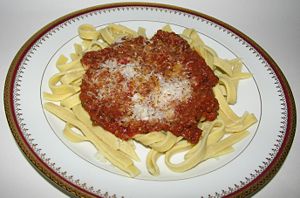
Bolognese sauce served on homemade tagliatelle with freshly grated Parmigiano-Reggiano cheese.
Tagliatelle is a well-known form of pasta that originated in the Emilia-Romagna region of northern Italy, where it is particularly known as being the classic accompaniment to Bolognese sauce. A single piece is a long, flat ribbon indistiguishable from fettuccine except for its slightly greater width of about 1/4th of an inch when cut and expanding up to nearly 1/2 of an inch when cooked. When made at home, as it typically is in Italy, it is too wide to be made in a household pasta machine and must be cut by hand. The noted food-writer Marcella Hazan says that Emilia-Romagna "enjoys uncontested recognition" as the birthplace of Italy's "finest" homemade pasta,[1] although the world-renowned spaghetti is not one of the local specialties. The basic homemade dough for tagliatelle, she says, consists only of eggs and soft-wheat flour, with spinach or Swiss chard being permitted for making green pasta. The homemade version, she notes, is "not as chewy as good factory pasta" and has "the capacity of absorbing sauces deeply."[2] Although spaghetti bolognese has become a worldwide standard, in Italy Bolgonese sauce is almost always served exclusively with tagliatelle.
| A typical homemade preparation of tagliatelle | ||||||||||||||||||||||||||
| ||||||||||||||||||||||||||
References
Sources
- Essentials of Classic Italian Cooking, by Marcella Hazan, Alfred A. Knopf, New York, 1992, ISBN 0-394-58404-X
